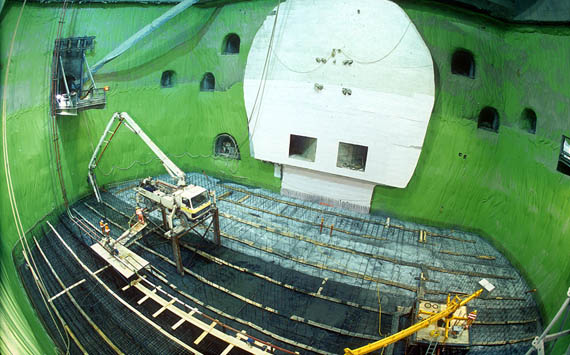 |
|
The Sensitive Giant by Matthew Hutson CERN's Large Hadron Collider, set to begin operations later this decade, will boast four new detectors around its 16-mile ring. Fermilab is heavily involved in the Compact Muon Solenoid, but the LHC is constructing another huge multipurpose detector in competition for discovery of the Higgs particle and several other fundamental targets: ATLAS, A Toroidal LHC ApparatuS. The quantity and diversity of the expected physics reflects the makeup of the ATLAS team itself: 1,850 physicists, from 150 institutions, in 34 countries. That's like two DZeros and a CDF combined.
"The individual is actually contributing to something," Gordon said. "He is doing something that he can handle." Bridging the teams are an Executive Board, Collaboration Board, Technical Coordination Team, and other groups. Spokesperson Peter Jenni of CERN said the collaboration is trying to use more modern management tools than in previous experiments, adding: "Of course we're still trying to preserve the spirit of a particle physics collaboration. We all share, after all, a common motivation: The exciting physics discovery potential of LHC. That is certainly the driving force." The discovery potential includes supersymmetry. The principle first theorized in 1970, positing a hidden world of "superpartners" for those particles observed so far, has not coughed up any experimental evidence in three decades of focused research. But Gordon said supersymmetry observations "could come out of the LHC in the first few weeks of data." And that's not all: "It would be easy to see evidence of extra dimensions if they exist," Gordon added. ATLAS stretches 45 meters long, 25 meters high, and 25 meters wide. (At 7,000 tons, it's actually lighter than CMS's 12,500 tons, but has much more volume.) On the very inside, ATLAS uses pixel detectors. Three layers of about 100 million silicon pixels, most 50 by 300 microns, will wrap around the beam tube to track particle locations. With this resolution, they can tell whether a particle came from the primary collision point or from a second decay only fractions of a millimeter away. As particles plow through all the other layers of the detector—each layer designed to count the momentum, location, and charge of a different set of particles—the detector must be quick-witted enough to know which events to watch. The colliding proton beams will produce a billion collisions per second inside the detector, and ATLAS's trigger will disregard all of them except the 100 or so it finds most interesting. ATLAS and CMS share physics goals, but diverge on a number of technologies. The electromagnetic calorimeter near the center of the detector, which tracks electrons, positrons and photons, takes a different form in each experiment. CMS uses an array of lead tungstate crystals, and ATLAS uses layers of lead plates separated by liquid argon and electrodes. ("I'm a liquid argon bigot," Gordon said.) Gordon worked on DZero's liquid argon calorimeter and says liquid argon allows finer segmentation and more stable calibration. But the CMS crystals excel in measuring energy fluctuations. "We have different camps about the best way to measure the physics prophecies that we expect from the LHC," Gordon said.
Perhaps the biggest challenge the ATLAS camp faces comes from its decision to use air-core toroidal magnets. Eight huge race-track-shaped coils of cable-filled pipe surround the detector's calorimeters. These toroids apply a magnetic field to muons escaping this far and help the muon detectors, on the very outside, measure their momenta. Unlike CMS, this feature gives ATLAS a muon measurement independent of the inner trackers. But new technology always poses problems. "The toroids themselves are beyond the state of the art," Gordon said. "They're a very challenging device." The sheer size of the magnets poses its own problem for the "ship-in-a-bottle" underground installation. Workers must lower fragments down two narrow shafts from the surface and piece the detector together in its cavern. "All these detector components have been pushed either beyond what was previously known or are new," Jenni pointed out. "For example, the radiation hardness for many of the components and the electronics, or the size of the cryomagnets. And the computing is a whole new world." At one megabyte per stored event, ATLAS will offer scientists a petabyte of data a year—plenty of data to go around. "The physics output of the LHC is so rich," Gordon said, "that we need lots of people because there are so many diverse channels to analyze. We will try to use the immense intellectual potential in this large collaboration. That's the main goal." The group goal also highlights the individual. "The idea is to empower the individual researcher," said Gordon, "and make sure that any individual who's in the experiment will have the opportunity for discovery." On the Web:
ATLAS at CERN
U.S. ATLAS collaboration |
| last modified 3/7/2004 email Fermilab |
FRLsDFx9eyfrPXgV

